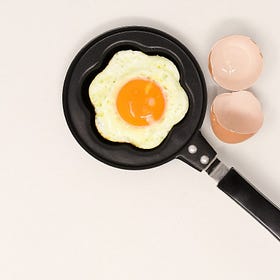Now, Seriously, What's So Tricky About Cholesterol?
We do have to know what on earth it does in our body, don’t we?
This article is the final part of a 3 part miniseries. The first 2 parts can be found at:
It Ain't Really Just The Cholesterol That Contributes To Heart Disease.
The cholesterol molecule is something that we have a problem with. On the one hand, it’s supposed to be good for us. As it is said on Medline, Cholesterol is a waxy, fat-like substance that's found in all the cells in your body. Your body needs some
The Problem With Cholesterol Accumulation In Our Body.
This piece is a continuation from It Ain’t Really Just The Cholesterol That Contributes To Heart Disease: There are certain things in life that we would want to see increases in. Financially, we will always appreciate an increase in our bank accounts. Emotionally, we will always appreciate an increased outpouring of love from our loved ones. Mentally, we will always appreciate learning new content that is relevant to us.
Medical science has been talking about cholesterol and its links to heart disease for years. People who are at risk of heart failure are invariably prescribed medicines such as statins by medical doctors to lower the cholesterol levels in their blood, in the hope that they would be able to protect one’s body against heart attacks and/or strokes as well.
We first have to look at the mechanism behind the synthesis and the elimination of cholesterol from the body.
The liver cells are the main synthesisers of cholesterol. However, as cholesterol is fat, it isn’t going to be transported by the blood really well. As an analogy, we can look at what happens when we mix oil and water. The oil tends to separate out from the water upon standing, and we see it floating on top of the water. They become two distinct liquids that are, in chemical engineering parlance, immiscible.
Immiscibility poses a problem. It ain’t easy for an essential ingredient be transported through the blood to the cell if it’s going to separate out from the blood into its own distinct liquid entity.
That’s when the lipoprotein comes in. A lipoprotein contains a hydrophobic (oil-loving) core and a hydrophilic (water-loving) exterior. In that way, the cholesterol particles can be packed into the core of the lipoprotein and zipped up, much like a backpack does for a student in carrying their textbooks to and from school.
The lipoprotein can then enter the blood, go to a cell, release some cholesterol and voila. The cholesterol transportation to the cell is completed.
Now, as oil floats on water, cholesterol will also float on water. We can say, again, in chemical engineering parlance, that the oil is of a lower density than water.
As a result, what happens to the density of the lipoprotein when it takes on its entire load of cholesterol at the liver? It decreases, relative to the density of the blood.
Any surprise now why they call it low density lipoprotein (LDL)?
As the LDL distributes its cholesterol cargo to all the cells, its density increases — hence we can call it high density lipoprotein (HDL). It can take some waste cholesterol from the cells back to the liver for disposal, but the amount of waste cholesterol that HDL carries is much less than the amount of fresh cholesterol that LDL carries.
Hence HDL’s density will be higher than LDL’s - it’s a consideration of how fully packed with cholesterol a lipoprotein is.
The liver then processes the cholesterol into bile salts, which are then dumped into the stool for excretion. Part of these bile salts can be reabsorbed back by the intestines into the blood.
Unfortunately, the longer the stools stay in the intestines, the more cholesterol will be re-absorbed and sent back out into the blood via the LDL. Poor liver function may also reduce the rate of bile salt processing and cause cholesterol accumulation too.
What happens, then, when more cholesterol gets re-absorbed?
Every other HDL protein will eventually accumulate enough cholesterol to become LDL.
Doesn’t this mean, then, that the blood cholesterol levels will increase?
Statin drugs have been prescribed by doctors to keep blood cholesterol levels under control. More than 35 million Americans are currently using statins for such purposes.
What do statins do? They block the synthesis of mevalonate by the HmG-CoA reductase (HmG-CR) enzyme by inhibiting the activity of HmG-CR. Mevalonate is a significant intermediary in the synthesis of cholesterol.
Hence, we’re looking at a reduction in the synthesis of fresh cholesterol.
10 Nutrients That Support A Healthy Heart
Supporting cardiovascular health is not an easy thing to do. We eat food. We exercise. We get stressed by work. We sleep. All these actions do contribute to the overall state of our immune system. As a result, if we ever do encounter situations such as high blood cholesterol in our middle age years (or later), we freeze. We don’t really know what to do. …
On the surface, it looks fantastic. People with high blood cholesterol ought to block the synthesis of new cholesterol. However, when we’re looking at a dynamic equilibrium:
Keep reading with a 7-day free trial
Subscribe to The Biochemistry Of Human Health to keep reading this post and get 7 days of free access to the full post archives.







